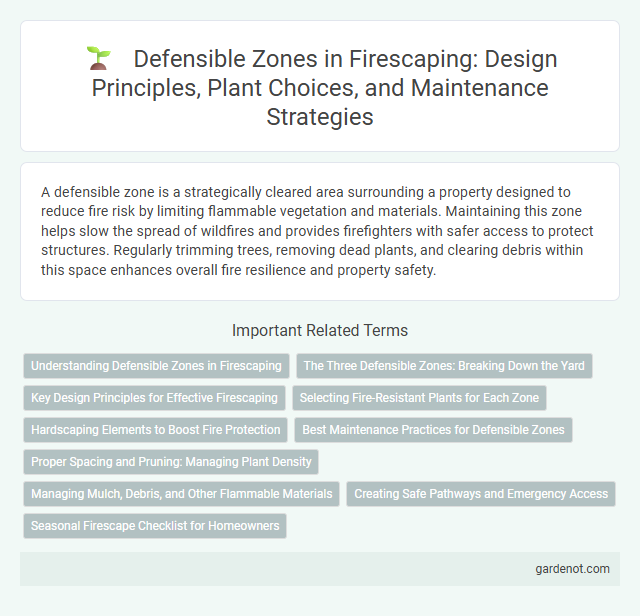A defensible zone is a strategically cleared area surrounding a property designed to reduce fire risk by limiting flammable vegetation and materials. Maintaining this zone helps slow the spread of wildfires and provides firefighters with safer access to protect structures. Regularly trimming trees, removing dead plants, and clearing debris within this space enhances overall fire resilience and property safety.
Understanding Defensible Zones in Firescaping
Defensible zones are strategically designed areas surrounding a structure that reduce fire risk by managing vegetation and combustible materials. Maintaining a clear, well-maintained space within 30 to 100 feet of a building helps slow the spread of wildfires and provides firefighters with safer access. Effective defensible zones integrate drought-resistant plants, regular debris removal, and proper spacing to enhance overall fire resilience.
The Three Defensible Zones: Breaking Down the Yard
The Three Defensible Zones in firescaping consist of the Immediate Zone (0-5 feet from the structure), the Intermediate Zone (5-30 feet), and the Extended Zone (30-100+ feet). Proper management involves reducing combustible vegetation, maintaining low-growing plants in the Immediate Zone, and spacing trees and shrubs strategically in the Intermediate and Extended Zones to slow wildfire spread. Creating these zones enhances fire resistance and provides firefighters with safer areas to defend the property effectively.
Key Design Principles for Effective Firescaping
Creating a defensible zone involves strategically spacing plants to reduce fuel continuity and incorporating fire-resistant vegetation to slow fire spread around structures. Utilizing hardscape elements such as gravel, stone pathways, and non-flammable barriers enhances protection by interrupting fire paths and minimizing combustible material near buildings. Regular maintenance like clearing dead vegetation and pruning lower branches maintains the zone's effectiveness by reducing potential ignition sources.
Selecting Fire-Resistant Plants for Each Zone
Selecting fire-resistant plants for each defensible zone is crucial to reducing wildfire risk around your property. In the immediate zone closest to structures, choose low-growing, well-irrigated plants with high moisture content, such as succulents and fire-resistant perennials. For outer zones, incorporate fire-resistant shrubs and trees like California lilac, manzanita, and pines with high ignition resistance to create natural firebreaks.
Hardscaping Elements to Boost Fire Protection
Hardscaping elements such as stone patios, concrete walkways, and gravel beds create effective defensible zones by acting as fire barriers and reducing combustible materials near structures. Incorporating non-flammable surfaces like brick driveways and metal edging enhances fire resilience and slows fire spread. Strategically placing these hardscape features around a property strengthens overall fire protection by interrupting fuel continuity and improving access for firefighting efforts.
Best Maintenance Practices for Defensible Zones
Regular removal of dead vegetation, trimming overgrown shrubs, and maintaining proper spacing between plants are essential best maintenance practices for defensible zones to reduce wildfire risks. Consistent clearing of flammable debris from gutters, roofs, and the ground around the property enhances fire resistance and supports effective defensible space. Periodic inspection and irrigation management help sustain plant health, preventing excessive dryness that can contribute to fire spread.
Proper Spacing and Pruning: Managing Plant Density
Proper spacing and pruning in the defensible zone are critical to reducing fire risk by limiting fuel availability and slowing fire spread. Maintaining adequate distance between plants and regularly removing dead or overgrown branches minimizes continuous vegetation that can act as a fire ladder. Effective management of plant density creates survivable spaces around structures, enhancing fire protection and increasing firefighter access.
Managing Mulch, Debris, and Other Flammable Materials
Maintaining a defensible zone requires careful management of mulch, debris, and other flammable materials to reduce wildfire risk. Removing dry leaves, pine needles, and excess mulch minimizes fuel that can easily ignite and spread fire near structures. Regularly clearing dead vegetation and storing flammable materials away from buildings enhances protection and supports effective firefighting efforts.
Creating Safe Pathways and Emergency Access
Establishing a defensible zone involves maintaining clear, debris-free pathways that facilitate safe evacuation and prompt emergency response. These access routes must be regularly inspected, kept wide enough for emergency vehicles, and free from flammable vegetation to prevent fire spread. Properly designed safe pathways enhance firefighter mobility and improve overall property protection during wildfires.
Seasonal Firescape Checklist for Homeowners
Creating a defensible zone involves clearing flammable vegetation and debris within 30 feet of the home to reduce wildfire risk. Seasonal Firescape Checklists for homeowners emphasize removing dead plants, trimming tree branches at least 10 feet from structures, and maintaining moist, well-irrigated landscaping. Regularly inspecting and updating these measures each season ensures optimal fire resistance and enhances community safety.
Defensible zone Infographic

 gardenot.com
gardenot.com